| Image
| Type
| Built
| Qty
| Used
| Added
| Edited
|
|
 |
HOA/IIA Bogie Aggregate/Sand Hoppers |
2006-2009 |
162 |
2006-current |
15/10/2014 |
10/05/2015 |
|
Almost from the start, EWS had ambitious plans to build many new wagons. However, its first order for aggregate hoppers was not placed until 2005, these becoming the HOA class. Delivered in EWS livery, many of the wagons were very soon repainted into the colours of their main user. A follow-on batch also wore this livery but were from a different builder and carrying 'international' numbers. More wagons to the latter design were ordered for use by Mendip Rail.
|
|
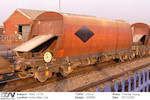 |
JGA RMC Bogie Stone Hoppers  |
1984-1997 |
89 |
1984-current |
01/10/2007 |
10/05/2015 |
|
The fleet of bogie hoppers used by Ready Mixed Concrete (RMC) wear a distinctive bright orange livery and until 2007 could be seen running in block formations carrying limestone from the quarry at Peak Forest near Buxton. The total of 89 wagons covers four batches built to three main designs over a period of 13 years, and trains often featured several or all of the variants. More recently the wagons have been in general use with EWS in the South East.
|
|
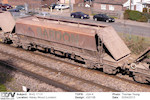 |
PHA/JGA Bardon Bogie Aggregate Hoppers  |
1986-2004 |
73 |
1986-current |
23/12/2007 |
10/05/2015 |
|
Bardon Hill Quarries (later renamed Bardon Aggregates) bought four batches of bogie hoppers between 1986 and 2004, totalling 73 wagons. They have been used in block formations between the quarries in Leicestershire and various terminals in the southeast of England.
|
|
 |
Air-Braked Bogie Steel Prototypes |
1976-1990 |
14 |
1976-current |
23/12/2007 |
10/05/2015 |
|
Five types of bogie steel wagon were built between 1976 and 1990, none of which entered serial production. First was the BLA of 1976 (a stretched BBA), then the YXA of 1985 (built to test new bogies). Finally the BGA/BHA/BJA family of 1990, a concerted effort to find replacements for the ageing BDA fleet as well as to provide better protection for steel loads. |
|
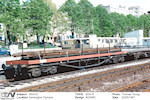 |
BCA/BDA Air-Braked Bogie Bolsters  |
1975-1981 |
1253 |
1975-current |
16/12/2007 |
10/05/2015 |
|
Over 1000 Bogie Bolster wagons were refurbished by BR in the 1970s with new bogies and air brakes. Most were 52ft long Bogie Bolster Ds, which became BDAs, but two Cs were also rebuilt, becoming the short-lived BCAs. A large proportion of the BDAs remain in service today, many having undergone modification for specific duties.
|
|
 |
IEA/IOA Network Rail Bogie Box Wagons |
2009 |
160 |
2009-current |
15/10/2014 |
15/10/2014 |
|
Greenbrier built two batches of bogie box wagons for Network Rail in 2009. 120 were high-sided wagons coded IOA and used in block formations to deliver ballast to virtual quarries. The other 40 were low-sided IEAs, assigned to general infrastructure work alongside similar wagons of types JNA and MLA.
|
|
 |
MLA Bogie Box Wagons |
2006-2008 |
245 |
2006-current |
15/10/2014 |
15/10/2014 |
|
The MLA code first appeared in 2006 and is applied to two batches of low-sided bogie box wagons used by three different operators. An initial batch of 140 yellow wagons was ordered by GB Railfreight for use on their Metronet contract, some being diverted to Network Rail. EWS followed this with 105 similar wagons but in a red livery. All are used for infrastructure duties.
|
|
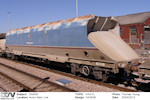 |
National Power JHA/JMA Hoppers (later HJA/HKA) |
1993-1995 |
106 |
1994-current |
15/10/2014 |
15/10/2014 |
|
In the mid-1990s, electricity generator National Power joined the small club of companies that ran their railfreight services using their own locomotives. Six class 59 locos and two batches of hoppers (totalling 106 wagons) carried a distinctive blue and grey livery on services centred on the giant Drax power station. The operation was short-lived, being sold to EWS in 1998. The rolling stock has seen more widespread usage under its new ownership, with many of the wagons being rebogied and renumbered.
|
|
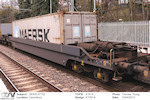 |
KQA/KTA Tiphook 'Pocket' Container Wagons |
1997-1998 |
75 |
1997-current |
02/01/2009 |
15/10/2014 |
|
The KQA/KTA wagons were another type specifically intended to permit the carriage of 9ft 6in tall containers within the UK loading gauge. With a distinctive slab-sided design, the wagons were initially given RIV numbers, but being used only on domestic Freightliner services, were later renumbered into the private-owner series. The method of carrying containers earned them the nickname Pocket wagons.
|
|
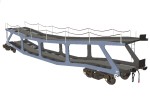 |
FQA/PJA/XMA Cartic-4 car carriers |
1964-1972 |
632 |
1964-2013 |
01/12/2006 |
01/09/2014 |
|
The tricky problem of efficiently carrying motor cars within the restrictive British loading gauge was definitively solved with the introduction of this revolutionary design in 1964. Made up of sets of four, double-decked wagons articulated across five small-wheeled bogies, the Cartics were not a huge success on Motorail services but came to dominate the transportation of new cars for the next 25 years.
|
|
 |
PIA/KPA Tiphook Hoppers and HQA/JJA Autoballasters |
1988-2006 |
400 |
1988-current |
20/10/2008 |
01/05/2013 |
|
Wagon hirer Tiphook bought 150 bogie hoppers in the late 1980s for spot-hires in various traffics. Within a few years most were stored out of use and one was modified as a ballast hopper with a view to replacing railway-owned types such as the Walrus and Sealion. The conversion, dubbed Autoballaster, was evidently a success and further batches accounted for the majority of the stored wagons. There was then a programme of building new Autoballasters with an order for 190 wagons followed by further batches of 50 and 10.
|
|
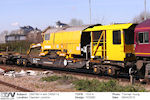 |
YEA Perch/Porpoise LWRT Trains |
1982-1985 |
192 |
1982-current |
01/12/2006 |
13/04/2010 |
|
When your cargo is 600ft long, you need a special type of wagon. The YEA wagons were part of an ingenious system designed to handle lengths of continuously welded rail, with the ability to unload single rails at work sites. The sets include components classified as on-track plant and the concept was obviously sound as new wagons built from 2002 shared the same configuration.
|
|
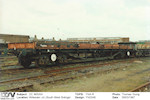 |
BPA/BRA/BXA Bogie Steel Rebuilds |
1979-1982 |
281 |
1977-current |
22/12/2007 |
16/03/2010 |
|
As well as a large number of Bogie Bolsters, three other types of bogie steel wagon received overhauls in the late 1970s and early 1980s. 51 Trestles, 80 Boplates and 150 Borails were fitted with air brakes and new bogies and recoded XVA, BPA and BRA respectively. As with many air-braked types, all three had very short lives in their initial roles. Transfers to the departmental fleet and modifications for alternate uses affected all 281 wagons and a wide range of TOPS codes have been applied. Despite their age, just over 200 wagons were still in stock in early 2008. |
|
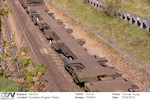 |
FEA Bogie Container Wagons  |
2003-2007 |
920 |
2003-current |
20/03/2008 |
16/03/2010 |
|
Although the first examples appeared as recently as 2003, the FEA intermodal flat wagon has proved popular with a variety of operators and over 900 were in stock by 2008. As well as carrying ISO containers the type is also used for infrastructure-related roles, for which specialised modules are fitted.
|
|
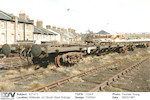 |
FFA/FGA Freightliner Flats  |
1964-1976 |
2137 |
1964-current |
01/10/2007 |
16/03/2010 |
|
The 1960s was a period of innovation for British rail freight, with many radically new designs appearing. The Freightliner wagons were a huge advance over the short wheelbase conflat wagons built before, and they were fortunately able to be adapted to the ISO standard for containers that emerged shortly after their introduction. As such, they carried the majority of intermodal rail traffic in the UK until their gradual replacement by newer types in the 1990s.
|
|
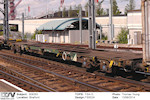 |
FSA/FTA Bogie Container Wagons  |
1991-1993 |
700 |
1991-current |
29/03/2008 |
16/03/2010 |
|
The 700 wagons that make up the FSA/FTA fleet represented proabably the largest investment in railway-owned wagons during the 1990s, and were also the first such vehicles to be imported rather than home-built. Fairly standard container-carrying wagons, they bolstered the ageing Freightliner fleet, allowing for retirement of many FFAs and FGAs.
|
|
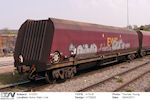 |
HTA Bogie Coal Hoppers |
2001-2004 |
1144 |
2001-current |
01/12/2006 |
16/03/2010 |
|
Soon after it was formed, EWS announced it was to buy a large number of new high-capacity wagons. One of the types indentified for replacement was the HAA merry-go-round coal hopper, all of which were between 18 and 36 years old. The design selected became the HTA, and a total of 1144 were built at the reopened York works between 2001 and 2004.
|
|
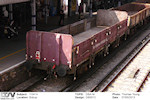 |
OAA/OBA Air-Braked Opens  |
1971-1979 |
900 |
1971-current |
22/12/2007 |
16/03/2010 |
|
The OAA and OBA types were open wagons with steel ends and wooden dropside doors, built in the 1970s for use on Air-Braked Network (ABN, later Speedlink) services. A decline in general merchandise traffic affected the fleet and many of the OBAs were transferred to departmental use within a few years. Later, both types saw a variety of modifications and conversions for other duties.
|
|
 |
YMO 'Salmon' Bogie Rail Wagons  |
1949-1983 |
895 |
1949-current |
01/01/2008 |
16/03/2010 |
|
The Salmon was a bogie rail wagon built in large numbers during BR's early years. Surprisingly, almost 400 remained in stock in 2008, most having been upgraded with air brakes and new bogies. The type is now mainly used for carrying track panels.
|
|
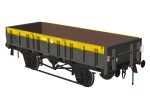 |
'Clam', 'Rudd' and 'Tope' Ballast Wagon Rebuilds  |
1984-1991 |
2069 |
1987-current |
01/01/2008 |
16/03/2010 |
|
The Clam, Rudd and Tope wagons were all rebuilds of HTV coal hoppers for use by the Civil Engineers. The Clam and Rudd conversions both involved the fitting of a new box body, the Rudds having dropside doors and air brakes. The Tope was a simpler job, merely having the original hopper body cut down in height and a solid floor fitted. The programme started in 1984 and, although scaled back, still involved over 2000 wagons, the vast majority of which appeared in the attractive grey and yellow livery. The vacuum braked Clam and Tope fleets were fairly rapidly withdrawn in the early 2000s, but the Rudds lasted longer, with over 200 still in use at the start of 2008.
|
|

























